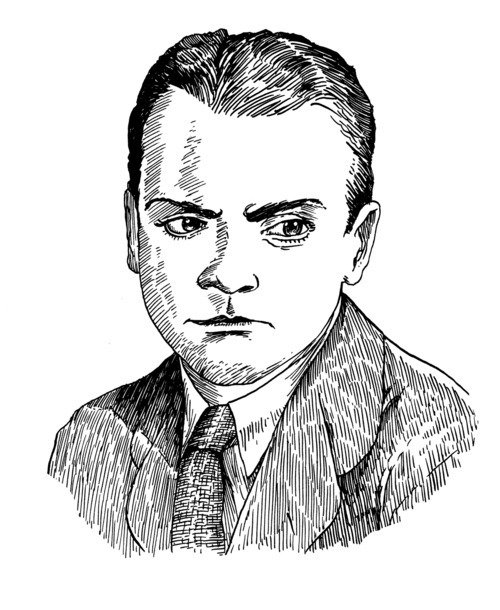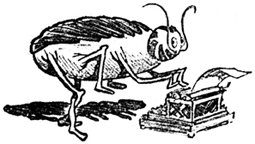
Méliès and “The Divisible Man”
Georges Méliès reimagined physics. And, in the process, put to shame Leonardo da Vinci’s Vitruvian Man. Renaissance empiricism was, momentarily, kaput. If one had a mind to catalogue Méliès’ ingenious transformations, then a plausible title might be “The Divisible Man”: detachable head, multiplying detachable head, expanding detachable head, the head as heavenly body, the body smithereened and reassembled… But of course a modern, tech-based art form like cinema makes “originality” itself suspect. Méliès cannibalized the works of Verne, H.G. Wells and Poe, or poached from their hunting grounds, without worrying in the least about copyright, and documented the same sorts of fantastic voyages to the moon, the south pole and the ocean floor, by outsize, inhabited artillery shell, by balloon or airship, rocket-train, or whatever fantastical machine could be cobbled together in his greenhouse studio. While the literary fantasists were somewhat concerned with credibility, with the science part of science fiction, the Frenchman with the upside-down head (bald top, hairy underside) focussed purely on visual possibilities: an idea was only any good if it gave you an IMAGE.

Cagney’s Last Hurrah
In 1961, upon completing his final scene in Billy Wilder’s Cold War comedy One, Two, Three, James Cagney announced his retirement to everyone on the set. Having made similar announcements so many times in the past (often walking away from studio contracts in the process), nobody took him all that seriously. This time, however, it stuck. He was approached countless times of course with screenplays and offers, but the more he said no, the easier he was finding it to say no. (Well, he did relent to narrate two TV movies, including The Ballad of Smokey the Bear, but never appeared on camera.) After some 60 films, he was tired of the business and the bullshit, and much preferred living a quiet life of semi-seclusion.
In 1980, well aware of what everyone else had encountered, director Milos Forman nevertheless approached Cagney with the script for Ragtime, a film based on the acclaimed novel by E.L. Doctorow.
At the time Cagney was 81 years old. He was suffering from diabetes and sciatica, and three years earlier he’d suffered a small stroke that left him unable to paint, ride a horse, or do any number of other things he’d so enjoyed. Understandably he slipped into a depression. Stories differ here, but when Forman approached him about Ragtime, Cagney’s wife and nurse both urged him to do the film, feeling it would be good for him to get out of the house and in front of the cameras for perhaps one last time.
Cagney, you might say, agreed to agree to do the film, on two conditions according to Forman. He did not want to sign a contract of any kind, and he maintained the right to change his mind and drop out at any point up to three days prior to his first scene. Nerve-wracking as such a deal was, Forman agreed and got underway with the pre-production.
Cagney’s scenes were set to be filmed in England, and when he stepped off the QE II (he always preferred boats), the crowd gathered to cheer him, security officials on the scene reported, were larger than they had ever seen before. And a few days later when Cagney appeared on the set (with still one day left to drop out if he so chose), everyone in the crew stopped what they were doing to give him a standing ovation. Again according to Forman, Cagney’s eyes welled with tears. It was only then that he finally and fully agreed to do the picture. The fact that he would be co-starring with his old friend and Irish Mafia cohort Pat O’Brien might have had something to do with it, too.
Those who were there during the shoot say Cagney never once flubbed a line even as those comparative youngsters around him did, and he was more than happy to hand out his share of advice and pointers to the other actors.
Sadly Cagney as NYC Police Commissioner Waldo does not appear until the final third of the picture. The assorted merits and lack thereof of Ragtime aside, there is simply something magical about Cagney on the screen. Even at 81 and suffering from a variety of health problems, his unmistakable physicality and voice are impossible to ignore, and snap the viewer back to attention. you want to see everything he does and hear every word he says. Sadly again, there’s not much of it. It’s an important role, but a small one—yet one that seems to make all the other actors in the film disappear, even when Cagney’s not on the screen. You know he’s there somewhere off-screen, doing something, and you just wait until he reappears.

Zis. Boom. Bah.

Walter Catlett: Wise Guy
Howard Hawks’s Bringing Up Baby (1938) was a long time shooting, and in the first few weeks, Katharine Hepburn wasn’t doing well. Hawks said later that she was telegraphing the fact that she was trying to be funny and it wasn’t working at all, so he had another actor in the picture, Walter Catlett, coach her and even read her part for her. Catlett was an old pro comic with long stage experience, and he made Hepburn see the dead serious, oblivious way that her screwball heiress Susan Vance should be played. Eventually Hepburn got the hang of it, and Catlett himself set down to work playing Constable Slocum (!), an easily distracted small town copper who huffs and puffs like a cartoon come to life.

Queens Don’t Make Revolutions
“Touch my lips to yours, like you do on Earth!”
In 1924 Yakov Protazanov dreams of Vertigo. Or maybe of Metropolis-Vier um die Frau. Or maybe just Soviet Socialist Republics…in space—his film from that year, Aelita, despite its stolid form is over-delirious with future possibilities.
A mysterious, indecipherable message is received by radio operators around the globe, but only a great Soviet engineer, one who has dreams of Mars and Martians, posits the absurd theory that maybe, possibly, it’s a message from outer space. It is difficult to understand why his head is in the clouds—he’s just married a beautiful girl and he seems in charge of terrific mechanical works for the great Soviet. Nevertheless, he dreams—during the day, surely, as we never see him asleep—of Mars and its beautiful, vamping Queen. Mars here is represented via Constructivist sets, cellophane and cardboard costuming and a preference for a kind of airy concreteness—ancient-like, spacious sets of granite, windowless openings, tall lines of wires and panes of glass—and seems appealing simply because its inhabitants are clearly human and its stylings so much more pristine, vivid, and, dare we say, chic, than the 1921 in which the film is set.

Moe Asch
When Moses “Moe” Asch died in 1986, his Folkways Records catalogue was up to two thousand one hundred and eighty-six long-playing records. It included LPs of folk ballads, calypso, Hawaiian and Polynesian and Japanese and African and Yiddish musics, bebop and free jazz and ragtime, gospel and civil rights songs, electronic and avant-garde music, spoken word recordings from Langston Hughes and Eleanor Roosevelt to Timothy Leary and Ho Chi Minh, plays and musicals, holiday records, humor records, children’s records, educational and instructional records, natural sound and sound effects records. A lot of it went pretty much unheard, then and now. But some of Asch’s releases changed the course of American popular culture.

“Cansky”
JAIL
“The main ghee (guy) is goin’ to the cansky in the mornin’.” -Born Reckless, Fox (1930)
From Daniel Riccuito’s The Depression Alphabet Primer, illustration by Tony Millionaire.

“Necktie Party”
A HANGING
Gallows humor was basic to 1930s underworld slang. Take “dance hall” (prison death house), so called because of the continual pacing of the condemned man.
From Daniel Riccuito’s The Depression Alphabet Primer, illustration by Tony Millionaire.

The Story of Temple Drake
A Southern gothic melodrama shot like a horror movie, this adaptation of Faulkner’s notorious Sanctuary is also a thornily ambiguous study in sex and morality. Miriam Hopkins, in an extraordinary performance, finds the high-strung, neurotic brittleness within the stereotype of a spoiled Southern belle. The racy opening establishes Temple as a tease who enjoys bringing college boys to the boiling point and then leaving them flat. But is she heartless, or is she frightened? And does she deserve to be punished with rape? When her date takes her slumming at a dilapidated plantation mansion-cum-speakeasy and passes out cold, her vulnerability is painful. Her blonde curls, bare shoulders and shimmering silk gown suddenly mark her not as a princess but as helpless prey, surrounded by slavering, animalistic men.
The one who finally attacks her (in a barn where sunlight sifts through the bars of a corn-crib) is a sleek, trigger-happy gangster played by Jack La Rue. Tall and dark, with impassive heavy-lidded eyes, La Rue, the eternal henchman of thirties gangland, exudes oily menace from every pore. Temple’s apparent acceptance of her rape raises the suspicion—both within the film and in readings of it—that she somehow enjoyed it. But Hopkins plays these scenes in a traumatized, almost catatonic stupor that suggests instead that she responds to shame and abuse by mentally shutting down. The film retains to the end an ambivalent but compassionate view of Temple, and the swampy atmosphere created by Karl Struss’s gauzy, expressionist camerawork conveys the oppressive mental haze through which she must grope for clarity.

Hope Don’t Gurgle: Don Marquis and Prohibition
Don Marquis was not only a humorist, author, poet and playwright, but from the 1910s into the mid-‘30s he was also perhaps the most popular and widely-quoted daily newspaper columnist in New York City. First at the Evening Sun and later at the Tribune, Marquis was known for his genial wit, his amusing poems, and for poking (usually) gentle fun at human foibles, city life, politics, religion, and the general state of things. Beneath the quips, however, was a deep, healthy skepticism and a disdain for hypocrisy and foolishness. As he himself once said, (and I’m paraphrasing here) “a humorist is someone who breaks the bad news gently.” The passage of the 18th Amendment gave him more than enough material to work with.
While not a heavy drinker by any means—certainly not compared to most of his contemporaries in the newspaper business—Marquis had nothing against the habit, and was not one to turn up his nose at the occasional double scotch. As he once penned in one of his famous bits of light verse:
If all the water on the globe
Should turn to beer and ale
I’d cast conventions to the wind
And play I was a whale
Working to his advantage here, Marquis’s columns were populated by a Runyonesque cast of (fictional) eccentrics, flim-flam men, and the occasional cat and cockroach, who sometimes spoke in verse giving Marquis poetic license (literally) to make some very pointed comments about what was happening in the world. Among the most popular of his characters was Clem Hawley, aka The Old Soak, a wise and drunken crackerbarrel philosopher.
Although introduced beforehand, it was after Prohibition became the law of the land in 1920 that The Old Soak became a star, even a hero. He was the focus of a couple of Marquis’s books as well as a popular stage play, a less popular sequel, a radio play, and two Hollywood films. It’s amazing nowadays to think a drunk thumbing his nose at The System could become such an iconic pop culture figure in the midst of Prohibition, but he was an invaluable commentator on just how foolish the whole fiasco was.
“I see that some persons think there is still hope for a liberal interpretation of the law so that beer and light wines may be sold,” said we.
“Hope,” said he, moodily, “is a fine thing, but it don’t gurgle none when you pour it out of a bottle. Hope is all right, and so is Faith … but what I would like to see is a little Charity.

The Curse of Ham
I love Laird Cregar with an almost sexual passion. The standard biographical stuff is necessary and heartbreaking: a fat character actor seemingly destined to occupy, with honour, the Sidney Greenstreet position in noirs, this natural heavy was also a fine light comedian, hired by Lubitsch to play Satan in Heaven Can Wait. But he longed to be a leading man, and embarked on crash diets out of a mad desire to become “slender as a sapling,” a misguided aim given the nature of his skills. And it killed him.
Fat or thin, Cregar was unlikely ever to have been another Robert Taylor. He played Jack the Ripper to acclaim in The Lodger, then lost the weight to play George Harvey Bone, the schizophrenic, lovelorn murderer of Patrick Hamilton’s wonderful novel Hangover Square (subtitled A Tale of Darkest Earl’s Court). Bone is described as heavyset in the book, so it was perverse of Cregar to slim for the part, and then to go on suspension at 20th Century Fox in protest at the fact that the screenplay was too unlike the source book. But perversity was this actor’s life’s blood.

“Flirting with the Undertaker”
RISKING LIFE AND LIMB
“Tell him that one more crack about me and he’s flirting with the undertaker.” For such swell threats, see a pip of a talkie – 1932’s Blessed Event, starring Lee Tracy.
Illustration by Tony Millionaire
Excerpt from Daniel Riccuito’s The Depression Alphabet Primer

